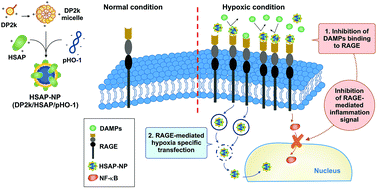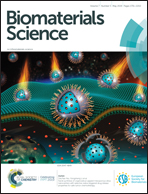A self-assembled DNA-nanoparticle with a targeting peptide for hypoxia-inducible gene therapy of ischemic stroke†
Abstract
A self-assembled nanoparticle composed of hypoxia-specific anti-RAGE peptide (HSAP), heme oxygenase-1 plasmid (pHO1), and deoxycholate-conjugated polyethylenimine-2k (DP2k) was developed for ischemic stroke therapy. RAGE is over-expressed and induces inflammation in the ischemic brain. To inhibit RAGE-mediated signal transduction, HSAP was produced by recombinant DNA technology, based on the RAGE-binding domain of high mobility group box-1. Because of the specific binding to RAGE, the nanoparticle with HSAP (HSAP-NP) may have dual roles as a cytoprotective reagent and a specific ligand to RAGE for receptor-mediated transfection. As a cytoprotective reagent, the HSAP-NP reduced RAGE expression on the surface of the brain cells by inhibiting the positive feedback of RAGE-mediated signal transduction. As a result, inflammation, apoptosis, and reactive oxygen species were decreased in hypoxic cells. As a gene carrier, HSAP-NP showed a higher transfection efficiency than polyethylenimine-25k, DP2k, and Lipofectamine. Particularly, HSAP-NP enhanced gene delivery to hypoxic cells. In the stroke animal models, HSAP-NP reduced the levels of RAGE, inducible nitric oxide synthase, and inflammation. Additionally, HSAP-NP with pHO1 (HSAP-NP/pHO1) increased HO1 expression in the ischemic brain. Gene expression was higher in hypoxia-inducible factor-1α (HIF-1α)-positive cells than in HIF-1α-negative cells, suggesting that HSAP-NP delivered the genes to ischemic tissues more efficiently. Cell death and infarct volume in the stroke models were significantly decreased by HSAP-NP/pHO1 compared with HSAP alone or the DP2k/pHO1 complex. Therefore, HSAP-NP may be a useful gene and peptide therapy system for stroke therapy with dual functions of hypoxia-specific gene delivery and cytoprotective effects.



 Please wait while we load your content...
Please wait while we load your content...